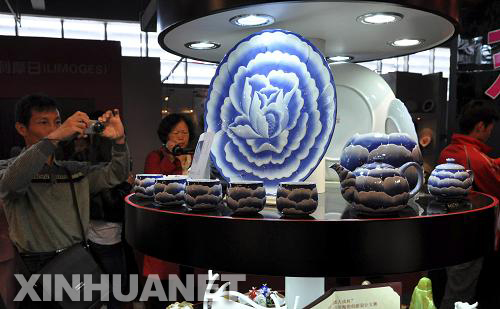Centuries-old ceramic pottery recreated in E. China
Gourd Ceramic, a treasured style of ceramic craftsmanship lost for three centuries, has come back to life in Jingdezhen, the dubbed ceramic capital of China in eastern Jiangxi Province.
|
|
After 18 hours of firing a gourd-shaped kiln, more than 300 Gourd ceramic pieces, mainly blue and white porcelain or pottery of ancient design, were recreated on Friday. This kind of ceramic work was last seen during China's Ming dynasty (A.D.1368-1644). The largest among the new pieces is a 60cm high blue and white porcelain wine vessel which is in the style of the ancients.
Ceramics archaeologists and antique experts from Jindezhen and China's Palace Museum, also known as the Forbidden City witnessed and authenticated the new Gourd ceramics.
"It is so amazing to recall the splendid times of China's porcelain by these 'reborn' Gourd ceramics," said Lai Qaunde, a Master of Arts and Crafts of China. The brightness of their glaze and the blue and white pattern have both reached the levels of the craftsmanship seen during the Ming dynasty."
He added that these newly produced Gourd ceramics had a gentle and mild glaze, marking a successful return of Gourd ceramic craftsmanship after centuries of not being in use.
Gourd ceramic, which made its appearance as early as the mid-14th century, was a typical style of ceramic craftsmanship. It lasted for more than 300 years in Jingdezhen under China's Ming Dynasty.
Jingdezhen, known as the ceramic capital of China, has a history of producing quality pottery going back 1,700 years. For hundreds of years, Jingdezhen represented the best in porcelain art throughout the world.
Gourd ceramic gets its name from the gourd-shaped kiln which was used to make the pots and other ceramic ware and featured two high ends and a low middle part. It was known for its high heat utilization and was most suitable for producing the well-known blue and white porcelain or archaic pottery.
The Gourd ceramic kiln combined the advantages of the dragon-shaped kiln and the steam-bread-shaped kiln -- both traditional forms of ceramic-making kilns in Chinese history. It had a large capacity and was much easier for the craftsmen to observe the porcelain procedure, said Zhou Ronglin, porcelain expert and head of the Jingdezhen Gourd ceramic reproduction team.
However, since the Qing dynasty (1644-1911), Chinese ceramics won international recognition and increasing global demand. But the Gourd ceramic kiln was mainly suited for showpieces and not really meant to cater to the massive demand for China's ceramics and was gradually replaced by other lager kilns.
"The Gourd ceramic kiln had been used in Jingdezhen for about 300 years, and played a unique role in China's porcelain history. Many ceramic treasures that were handed down for centuries came from it," Zhou said, adding that it would be a pity if people nowadays could only appreciate the art form in historical books and didn't have the chance of seeing or touching it.
To protect and continue the legacy of Jingdezhen ceramic craftsmanship, the bureau of culture in the province started the Jingdezhen Gourd Ceramic reproduction project this January.
Top porcelain experts made an on-the-spot investigation at the archaeological site of ancient kilns of the Ming Dynasty before finally restoring the 9.2-meter-long Gourd ceramic kiln.
Yu Yunshan, the 68-year-old sole descendent of the Ming dynasty kiln builder, was responsible for recreating the Gourd ceramic kiln.
"The entire project followed the idea of passing down the cultural heritage in the ceramic capital in a scientific spirit," Yu said. All the bricks and china clay used in the kiln were the same as the traditional formula, and all the methods were copied from classical books.
The successful recreation of the Gourd ceramic kiln acknowledges the brilliant craftsmanship during China's Ming Dynasty. "It is a living museum to show how craftsman created the porcelain, as well as preserved their traditional techniques," said Zhou.X He added that "the 'rebirth' Gourd ceramic craftsmanship will also add value to China's porcelain industry as archaic pottery is so popular and valuable."
Jingdezhen city now plans to rebuild other forms of traditional kilns that have been lost over time.
"We are ready to reproduce the spectacular time of Jingdezhen, as the ceramic capital of China and as a symbol of world-class porcelain art," said Chen Wuping, director of the Jingdezhen Ceramic Culture Exhibition District.
 0
0 







